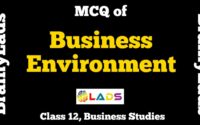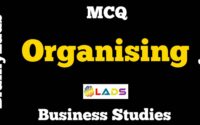MCQ of Planning | Class 12 | Business Studies | Term 1 | Part A |
MCQ of Planning | Class 12 | Business Studies | Term 1 | Part A |
Q1. Planning refers to
a. thinking while doing
b. thinking after completion of work
c. Thinking beforehand
d. None of these
Answer: Thinking beforehand
Q2. Planning is _____ function of management
a. Second
b. Last
c. Primary
d. Least important
Answer : Primary
Q3. Which of the following is essential feature of planning?
a. Related to human beings
b. It is a mental exercise and all pervasive process
c. It is the means of motivation
d. It integrates employees efforts
Answer : It is a mental exercise and all pervasive process
Q4. Planning reduces _____ activities
a. Important
b. Physical and mental
c. Overlapping and wasteful
d. Social
Answer: Overlapping and Wasteful
Q5. Standards for controlling is established by
a. Planning
b. Directing
c. Staffing
d. Organising
Answer: Planning
Q6. Planning does not work in _____ environment.
a. Social
b. Dynamic
c. Stable
d. Economic
Answer : Dynamic
Q7. Planning process:
Setting objectives ➡ developing premises ➡ _____ ➡evaluating alternative courses.
a. Selecting an alternative
b. Implementing plan
c. Follow up action
d. Identifying alternative courses of action
Answer : Identifying Alternative Courses of Action
Q8. What are premises?
a. It refers to thinking before hand
b. It refers to make changes in past
c. It refers to make certain assumptions about the future
d. None of these
Answer : It refers to make certain assumptions about the future
Q9. Internal premises include
a. Government policies
b. Business competition
c. Capital and Labour
d. Rate of taxes
Answer: Capital and Labour
Q10. External premises include
a. Raw material
b. Business competition
c. Machinery
d. Labour
Answer : Business Competition
You may also read MCQ of Nature and Significance of Management, MCQ of Principles of Management, MCQ of Business Environment, MCQ of Organising , MCQ of Marketing Management for scoring higher in forthcoming examination.
Q11. Plan is categorized into
a. Old plans and new plans
b. Standing plan and single use plan
c. Old plans and modern plan
d. None of these
Answer : Standing Plan and Single Use plan
Q12. Standing plans is also called
a. Repeatedly used plans
b. Modern plans
c. Adhoc plans
d. Simple plans
Answer : Repeatedly Used Plans
Q13. Single use plans is also called
a. Repeatedly used plans
b. Modern plans
c. Adhoc plans
d. Simple plans
Answer: Adhoc plans
Q14. To make the employment available to 100 people every year is
a. a policy
b. a strategy
c. an objective
d. a purpose
Answer: An objective
Q15. Which of the following is feature of ‘Objectives’ ?
a. They should be unambiguous
b. They should be measurable
c. They should be achievable
d. All of these
Answer: All of these
Q16. What are policies?
a. Special target to be achieved by an organization
b. It tells us how an organization is different from the organization of the same type
c. It refers to those general statements which are decided for the guidance of the employees while taking decision
d. It refers to thinking before hand
Answer : It refers to those general statements which are decided for the guidance of the employees while taking decision
Q17. _____ describes the desired results in numerical terms
a. Budget
b. Method
c. Policy
d. Strategy
Answer : Budget
Q18. What is method?
a. It describe the desired results in numerical terms
b. It is that plan which determines how different activities of the procedure are completed
c. It refers to the quantitative expression of the plan of action
d. It is a general guideline which brings uniformity in decision making
Answer : It is that plan which determines how different activities of the procedure are completed
Q19. Budget is an instrument of both _____ and _____ hence no question of selection arises.
a. Directing and controlling
b. Planning and organising
c. Organising and controlling
d. Planning and controlling
Answer : Planning and Controlling
Q20. ‘ No smoking in the factory’ is an example of:
a. Rule
b. Procedure
c. Method
d. Policy
Answer : Rule
Q21. Procedure is a guide to…
a. Employees
b. Manager
c. Action
d. Decision making
Answer : Action
Q22. Policy is a guide to
a. Employees
b. Manager
c. Action
d. Decision making
Answer : Decision Making
Q23. Under which Policy, it can be decided that the goods will be sold only on cash payment.
a. Personnel Policy
b. Government policy
c. Sales policy
d. Price – determining Policy
Answer : Sales Policy
Q24. ___ provide a basis for interpreting strategy, which is usually stated in general terms.
a. Policies
b. Procedures
c. Objectives
d. Programmes
Answer : Policies
Q25. The exact manner in which any work is to be performed is detailed through ____
a. Rules
b. Methods
c. Procedures
d. Programmes
Answer : Procedures
Q26. ____ helps to save time, money and effort, and increases efficiency.
a. Procedure
b. Programme
c. Rule
d. Method
Answer: Method
Q27. Plan which quantifies future facts and figures is called _____
a. Procedure
b. Programme
c. Rule
d. Budget
Answer : Budget
Q28. Which of the following is not a standing plan?
a. Policy
b. Procedure
c. Programme
d. Rule
Answer : Programme
Q29.Which of the following is not a single use plan?
a. Budget
b. Programme
c. Method
d. All of the above
Answer : Method
Q30. Karam wants to increase the sale of his business by 20% in the next quarter. Identify the type of plan being described in the above lines.
a. Method
b. Objective
c. Strategy
d. Programme
Answer : Objective
Do share this post if you liked the MCQ of Planning. For more updates, keep logging on BrainyLads


